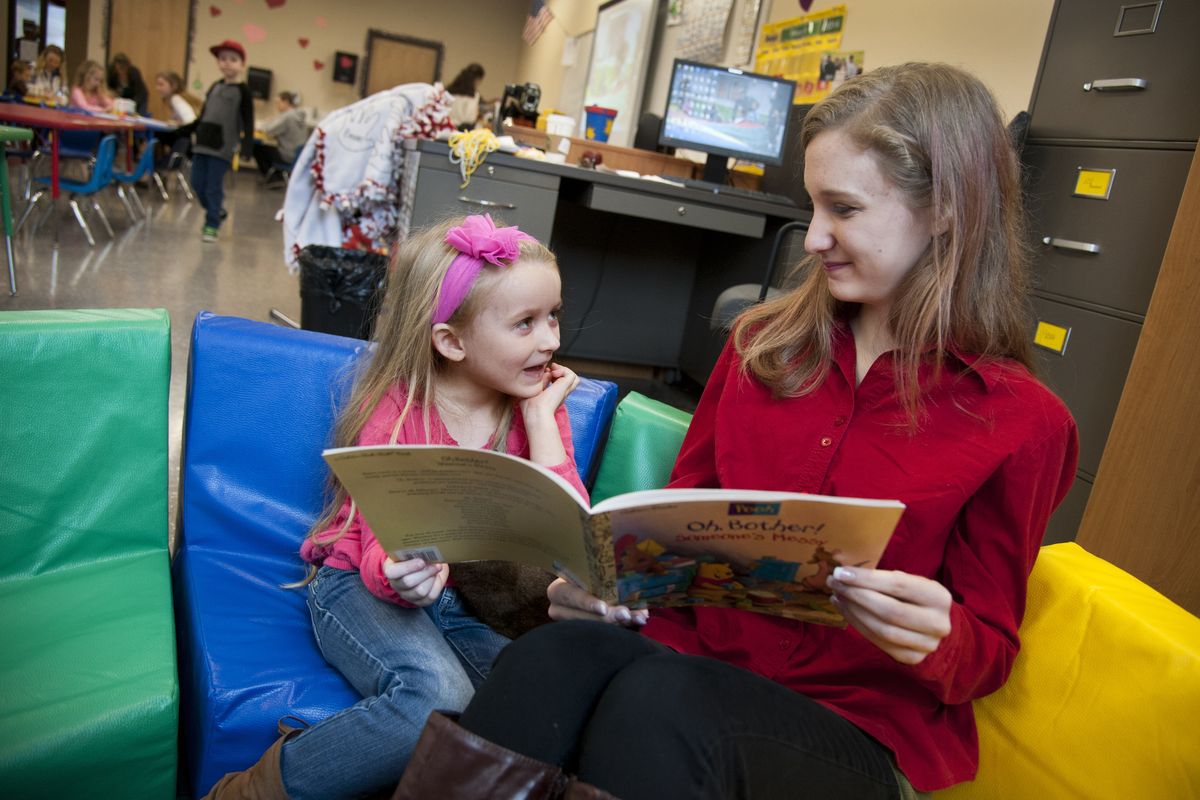Preschools’ benefits unavailable to many in Spokane County, state
Ferris High School junior Rebecca Haynes, 17, reads a Winnie the Pooh book titled “Oh, Bother! Someone’s Messy” to Ferris Preschool student Bryn Johnson, 4, during morning class time Tuesday. (PHOTOS BY DAN PELLE)
Tiny voices buzzed and toys clattered in the preschool classroom at Ferris High School, a cacophony of indistinct sounds until a 4-year-old proclaimed her victory.
“I did the puzzle all by myself,” said Kaylee Smith, 4, who sat quietly at a kid-size table by herself.
Kaylee spends two hours a day, three days a week in the preschool room with 23 other 3- to 5-year-olds. The prekindergarten group is paired with high school students taking an early-learning education course, creating an almost one-to-one learning environment. The teens and a classroom teacher work with the kids on their cognitive, social and physical abilities.
The program, also offered at Shadle Park, North Central and Rogers high schools, is available to children of high school employees and a few neighborhood residents.
The waiting list to get children in is about three years long.
Preschool is a hot topic nationwide. President Barack Obama has set aside $75 billion in his 2015 budget to further his Preschool for All initiative. This is Obama’s second attempt to include the item in the federal budget.
New York Mayor Bill de Blasio ran on a promise of preschool. The Seattle City Council approved a resolution to make preschool available and affordable to all 3- and 4-year-olds, and several council members in Boston and New Jersey researched options last week.
While states such as Georgia, Alabama and Montana are moving ahead with universal public preschool, Washington is trailing behind – a position not too different from its pace offering universal full-day kindergarten.
“The universal pre-K conversation is one we continue to have, but we are not there yet,” said Amy Blondin, government and community relations manager at Washington’s Department of Early Learning. “Our state is a leader in terms of quality, but not necessarily in terms of access.”
Without quality preschool, kids are entering school behind in math and reading, unable to socialize properly and unsure how to behave, based on Washington’s kindergarten assessment results. Repeated studies show students who attend preschool are more likely to graduate from high school and less likely to commit crimes or become pregnant as teenagers.
“Preschool, if handled correctly – in the right segments, not too many hours – is needed; two hours per day, three days per week is perfect,” said Nancy Crater, Ferris High School’s lead early childhood education teacher. “Let’s not turn it into child care.”
She added, “I think it’s a great preparatory tool, especially for what they will be expected to do in kindergarten.”
Ferris High School’s program is among fewer than 75 public preschool possibilities in the Spokane area; there are nearly 30,000 children 4 years old or younger in Spokane County.
There will be 176,668 preschool-age children in Washington by next year, yet fewer than 50,000 state-funded and federally funded slots will be available in 2014-15. About 288 of those are in Spokane Public Schools classrooms, and another 300 are in the Central Valley School District.
Spokane Superintendent Shelley Redinger, an early-learning advocate, said she has no plans to make preschool available to all children within the district because funding and space are too hard to find.
One solution is to look for community partners, a search that is now underway.
“There’s such good evidence about preschool. It helps with postsecondary. It helps with special education,” Redinger said. “That is a goal, to increase the number of early-learning classrooms.”
The tricky part is money, she said. “That’s going to take some legislative movement. I do think the state will really have to make some decisions and start prioritizing.”
Lawmakers are still trying to fund K-12 basic education following a court decision. Although a large installment was provided this year, there are still millions of dollars to go.
Meanwhile, a bill signed into law in 2010 is expected to open up preschool options for the state’s most disadvantaged children.
Washington’s state-funded Early Childhood Education and Assistance Program makes preschool available to children in families who meet the poverty threshold. For a family of four, that’s $26,000 in annual income. Children who are developmentally delayed, involved with Child Protective Services or in foster care also qualify.
Currently, there are 10,091 slots available and about 3,000 children on a wait list, according to the Department of Early Learning. “Our state is serving about 39 percent of the eligible population,” said Blondin, the department spokeswoman.
By 2018-19, all eligible children will be able to enroll, an estimated 22,807, Blondin said.
Still, thousands of families will have to pay for preschool or skip it.
“It used to be all kids needed to know was their ABCs, their colors, their shapes … that’s not enough,” Blondin said. “Kids need the social and emotional and physical too.”

